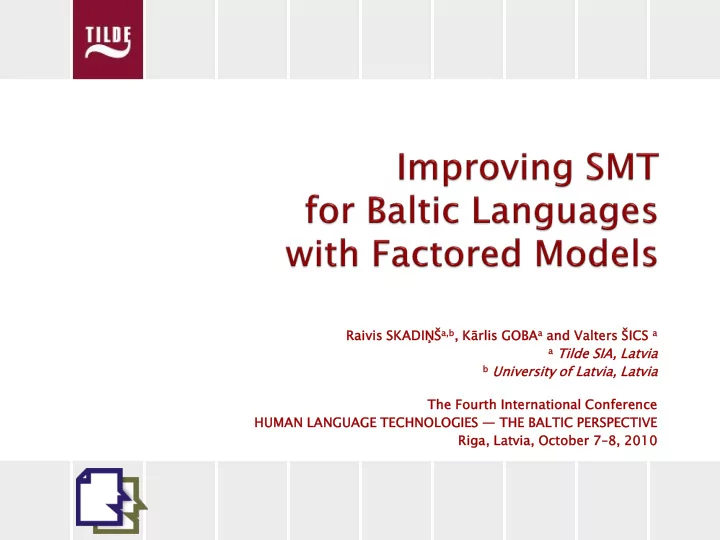

Raivis SKADIŅŠ a,b a,b , Kārlis GOBA a and Valters ŠICS a a Tilde SIA, Latvia ia b University sity of Latvia ia, Latvia ia The Fourth Internatio ional nal Confer eren ence ce HUMAN N LANGUA UAGE GE TECHNO NOLOGIE GIES — THE BALTIC C PERSPE SPECT CTIVE IVE Riga, , Latvia, via, October 7 – 8, 2010
Current situation with Latvian & Lithuanian MT Motivation of this research SMT with factored models ◦ English-Latvian ◦ Lithuanian-English Evaluation The latest improvements
Latvian ◦ MT in Tildes Birojs 2008 (RBMT) ◦ Google Translator (SMT) ◦ Microsoft Translator (SMT) ◦ Pragma (RBMT) ◦ IMCS system (SMT) Lithuanian ◦ Google Translator (SMT) ◦ Bing Translator (SMT) ◦ VMU system (RBMT)
Both Latvian and Lithuanian ◦ Morphologically rich languages ◦ Relatively free order of constituents in a sentence Small amount of parallel corpora available We were not happy with a quality of existing MT Goal ◦ not to build yet another SMT system using publicly available parallel corpora and tools ◦ to add language specific knowledge to assess the possible improvement of translation quality
There are good open source tools (Giza++, Moses etc.) and even some training data available (DGT-TM, OPUS) Why it is not so easy to build SMT for Baltic languages ◦ Rich morphology ◦ Limited amount of training data Translating from English ◦ How to chose the right inflected form ◦ How to ensure agreement ◦ How to deal with long distance reordering Translating to English ◦ Out of vocabulary issue ◦ How to deal with long distance reordering
The main challenge – inflected forms and agreement Simple SMT methods relay on size of training data Factored methods allow integration of language specifics ◦ Lemmas, morphology, syntactic features, … There is no one best way how to use factored methods Solution depends on language pair and available tools
Training data: Bilingual corpus Parallel units Localization TM ~1.29 mil. DGT-TM ~1.06 mil. OPUS EMEA ~0.97 mil. Fiction ~0.66 mil. Dictionary data ~0.51 mil. Total 4.49 mil. (3.23 mil. filtered) Monolingual corpus Words Latvian side of parallel corpus 60M News (web) 250M Fiction 9M Total, Latvian 319M
Development and evaluation data ◦ Development - 1000 sentences ◦ Evaluation – 500 sentences ◦ Balanced Topic Percentage General information about European Union 12% Specifications, instructions and manuals 12% Popular scientific and educational 12% Official and legal documents 12% News and magazine articles 24% Information technology 18% Letters 5% Fiction 5% Tools ◦ GIZA++, Moses, SRILM ◦ Latvian morphological tagger developed by Tilde
Factored models ◦ More than 10 different models tried ◦ Here presented (1) gives good results and (2) is reasonably fast System Translation Models Language Models 1: Surface Surface EN-LV SMT baseline 1: Surface form 1: Surface Surface, suffix EN-LV SMT suffix 1: Surface form 2: Suffix 1: Surface Surface, morphology tag EN-LV SMT tag 1: Surface form 2: Morphology tag
Automatic evaluation System Language pair BLEU Tilde rule-based MT English-Latvian 8.1% Google English-Latvian 32.9% Pragma English-Latvian 5.3% SMT baseline English-Latvian 24.8% SMT suffix English-Latvian 25.3% SMT tag English-Latvian 25.6% Human evaluation System1 System2 Language pair p ci ±4.98 % SMT tag SMT baseline English-Latvian 58.67 % ±6. 01 % Google SMT tag English-Latvian 55.73 %
The main challenge – out of vocabulary Simple SMT methods relay on size of training data We do not have a morphologic tagger for Lithuanian Simplified approach – splitting each token into two separate tokens containing the stem and an optional suffix. The stems and suffixes were treated in the same way in the training process. Suffixes were marked to avoid overlapping with stems.
Training data: Bilingual corpus Parallel units Localization TM ~1.56 mil. DGT-TM ~0.99 mil. OPUS EMEA ~0.84 mil. Dictionary data ~0.38 mil. OPUS KDE4 ~0.05 mil. Total 3.82 mil. (2.71 mil. filtered) Monolingual corpus Words English side of parallel corpus 60M News (WMT09) 440M LCC 21M Total, English 521M
Development and evaluation data ◦ Development - 1000 sentences ◦ Evaluation – 500 sentences ◦ Balanced (the same set of English sentences as before) Topic Percentage General information about European Union 12% Specifications, instructions and manuals 12% Popular scientific and educational 12% Official and legal documents 12% News and magazine articles 24% Information technology 18% Letters 5% Fiction 5% Tools ◦ GIZA++, Moses, SRILM ◦ A Simple Lithuanian stemmer developed by Tilde
Models System Translation Models Language Models 1: Surface Surface LT-EN SMT baseline 1: Surface form 1: Stem/suffix Surface LT-EN SMT Stem/suffix 1: Surface form 1: Stem Surface LT-EN SMT Stem 1: Surface form
Automatic evaluation System Language pair BLEU Google Lithuanian-English 29.5% SMT baseline Lithuanian-English 28.3% SMT stem/suffix Lithuanian-English 28.0% System Language pair OOV, Words OOV, Sentences SMT baseline Lithuanian-English 3.31% 39.8% SMT stem/suffix Lithuanian-English 2.17% 27.3% Human evaluation System1 System2 Language pair p ci ±4.14 % SMT stem/suffix SMT baseline Lithuanian-English 52.32 %
Translating from English ◦ Human evaluation shows a clear preference for factored SMT over the baseline SMT ◦ However, automated metric scores show only slight improvement Translating to English ◦ Simple stem/suffix model helps to reduce number of untranslated words. ◦ The BLEU score slightly decreased (BLEU 28.0% vs 28.3%) ◦ OOV rate differs significantly. ◦ Human evaluation results suggest that users prefer lower OOV rate despite slight reduction in overall translation quality in terms of BLEU score.
English-Latvian and Latvian-English systems have been released: http://translate.tilde.com BLEU scores System Language pair BLEU translate.tilde.com English-Latvian 33% translate.tilde.com Latvian- English 41% Human evaluation System1 System2 Language pair p ci ±4. 60 % Google translate.tilde.com Latvian-English 56.73 % ± 3.62 % Google translate.tilde.com English-Latvian 51.16 %
Recommend
More recommend